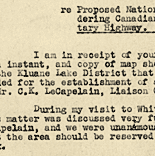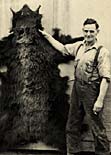Wildlife, the Environment and the Economy
Wartime construction projects were built with little concern or awareness for their environmental effects. Wilderness was treated as infinite, and much of the Yukon was considered uninhabited, even though First Nation people had been there for centuries.
Construction of roads led to destruction of wilderness. ca. 1942. (view more details)
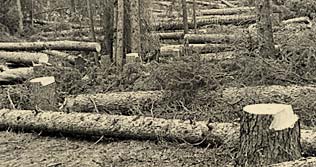
Wide-scale destruction of wildlife was never officially documented, but there were stories that circulated amongst local residents, government officials and outside interested parties. The total effect of the construction on Yukon wildlife has probably been exaggerated; however, hunting did increase during the war-time years in places where it had not happened before and game populations declined accordingly. Hunting was made convenient for soldiers and Public Roads Administration workers, who were granted resident hunting permits. Locals were appalled by wildlife being killed by outsiders and then left to rot. Many soldiers killed game and ate it to supplement daily rations which provided little or no fresh food. In the years following construction, the highway opened up new hunting territory and new opportunities for roadside shooting. In addition, fast-traveling traffic subjected wildlife to noise, dust and, fatal collisions with vehicles.
Employees after shooting two bears... (view more details)
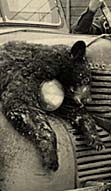
There were restrictions on hunting in limited areas along the route of the Alaska Highway. The development of Kluane National Park began in 1942 with the federal government’s desire to protect Canada’s largest glaciers and mountains in the St. Elias range. The following year the Yukon Government declared the same area a game sanctuary and prohibited hunting by everyone, including First Nations. Interestingly, a ban was not placed on mineral exploration in the Alaska Highway corridor as was done in the state of Alaska. And there were no restrictions placed on hunting along the rest of the Yukon portion of the Alaska Highway corridor.
Issues of pollution and waste management, although sometimes considered, were not dealt with in the same manner as today. The hazards of oil leaking from the Canol pipeline or left after the dismantling of the Canol refinery in Whitehorse were not understood. The standard practice for handling oil seepage was to burn off the escaped oil or to let it drain into unlined pits. There were many cases of oil leaks due to sabotage or cracks in pipeline unfit for arctic temperatures.
An accumulation of construction equipment in Whitehorse in 1944 (view more details)
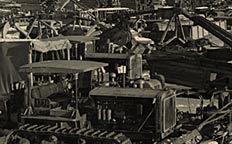
After construction, many camps were abandoned and equipment and buildings left behind. Rusting vehicles and dilapidated buildings are still evident along the Canol Road, left in haste after the pipeline was complete. There are witnesses to mass burnings of items that the Army and Public Roads Administration wanted neither to ship outside nor give away to locals, including food, mattresses, blankets, clothing, etc.

